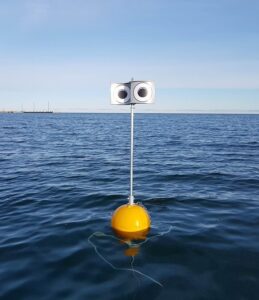Looming-eyes buoy
WHAT ARE LOOMING EYE BUOYS?
The looming-eyes buoy aims to deter diving seabirds from entering the area around static gillnets. Static gillnets pose a threat to seabirds as they are made of a monofilament nylon, which is virtually invisible to foraging seabirds diving under the water, so birds can become entangled. In recent years, the looming-eyes buoy has been designed a way to keep seabirds away from these problem areas, by affixing pairs of conspicuous “eye-spots”on floating buoys – much like a scarecrow.
These looming eyes, bobbing and spinning in the water at the end of a tall pole, are believed to evoke a behavioural avoidance response in birds, preventing them not only from diving near the gillnets, but from entering the area at all. A prototype has been made from carbon and steel, featuring a panel that rotates in the wind, allow the device to spin and creating a movement that stops birds from ‘habituating’ to the device.

Looming-eyes buoy from the Birdlife International Estonia project, by Andres Kalamees
CURRENT RESEARCH & USE
A 2021 trial in the Baltic Sea found that long-tailed duck presence declined by 20-30% within a 50m radius of the looming-eyes buoy, in a controlled experimental setting. No evidence was found for a memory effect on the ducks, but some habituation was noted within the 62-day time frame. These preliminary trials suggest that the looming-eyes buoy (and above-water devices more generally) could contribute to reducing seabird bycatch. However, in a more recent trial in the Icelandic lumpfish fishery, the buoy was found to have no significant effect on rates of bycatch of eider ducks or guillemot species. Another trial undertaken in the Baltic Sea found that while the numbers of cormorants, gulls, and terns congregating near pound nets (fixed net traps targeting migrating fish) initially fell, this effect wore off after a month, likely because the birds habituated to the buoys – leading the researchers to conclude that the device is not a solution for passive gear fisheries, at least in the study region.
The RSPB, Birdlife International, Cornwall IFCA, and Natural England (NE), have collaborated with gillnet fishers along the south and west coast of Cornwall to trial two devices to see whether they provide an effective and practical measure for reducing seabird bycatch. This trial was intended to look at both looming-eyes buoys and predator-shaped kites with the help of local fishers, comparing those to traditionally used nets. The trial focused on the Falmouth Bay to St Austell Bay Special Protection Area (SPA) which is important for black-throated diver, great northern diver and Slavonian grebe. Shag, cormorant, razorbill and guillemot also occur there. The RSPB received a £50k funding boost from the DEFRA G7 Legacy Fund for the project. This was used for the purchase of the buoys and predator kites, as well as engaging with local fishers to involve them in the research. More details can be found on the Cornwall IFCA website.
Interested in how this and other measures could mitigate bycatch in your fishery? Get in touch with us to collaborate or take part in a study.
This page was last updated on 04.12.24.
